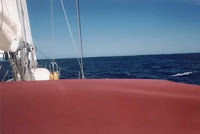For Charlie and Scout
About Me

- John Lichty
- Savannah,
Georgia, USA
"Go confidently in the direction of your dreams. Live the life you have imagined." --Henry David Thoreau
 Raising Charlie: The Lessons of a Perfect Dog by John Lichty
Raising Charlie: The Lessons of a Perfect Dog by John Lichty
Blog Archive
Followers

Recommended Links
- ATN Sailing Equipment
- ActiveCaptain
- BoatU.S.
- Coconut Grove Sailing Club
- Doyle Sails - Fort Lauderdale
- El Milagro Marina
- John Kretschmer Sailing
- John Vigor's Blog
- Leap Notes
- Noonsite.com
- Notes From Paradise
- Pam Wall, Cruising Consultant
- Practical Sailor
- Project Bluesphere
- Sail Makai
- So Many Beaches
- Windfinder
Thursday, December 27, 2007
Boat Quest, Part 4
Later that summer, I made a pilgrimage to Colorado's only MacGregor dealer, The Anchorage, located just north of Boulder and only a four-hour drive away. The owners, Eileen and John, let me climb around on a brand-new MacGregor 26X and gave me literature and a price sheet. I left convinced that the MacGregor was the right boat for me after all. And I rationalized that it would be easier to come up with financing for a new boat than for an older, used boat. We might have qualified for a home equity loan, but the mortgage on our Aspen home was oppressive enough without taking on additional debt, so I never got past checking interest rates and calculating monthly payments.
That fall, Nan and I attended the wedding of Erika and Mike in Moab, Utah. Erika and Nan worked together in the pharmacy at Aspen Valley Hospital. Their boss, the pharmacy director Dan Gold, was also a guest at the wedding. Nan had been eager for me to meet Dan because she thought we had many interests in common, including sailing. Dan was late getting to the sunset wedding after riding the challenging Monitor and Merrimac trail on his mountain bike, so we met only briefly before the ceremony, which took place beneath one of the arches in Arches National Park. The reception was a low-key affair at Eddie McStiff's brew pub, where Dan and I talked sailing and became friends over pitchers of microbrew. Like me, Dan was a believer in the MacGregor 26, in his case because he owned one, a 1992 MacGregor 26D.
Tuesday, December 18, 2007
Christmas Letter 2007
 Dear Family and Friends,
Dear Family and Friends,Time passes so quickly these days, our Christmas letters are starting to read like chapters in a serialized novel. By the time the last one has been mailed, it’s time to start thinking about the next. What to do for a cliffhanger though?
This year was a big one for us. We made up for all the travel and experiences we didn’t get to do last year while we were going through our home ownership transition. Much of that travel was the back-and-forth shuffle between our jobs at Aspen Valley Hospital and our home in Grand Junction. We shared a house down the road from Aspen in Basalt during the work week and drove home every weekend, partly to water the plants and check the mail, partly because it was home and it felt right to be there. But as of November 1st, when Nan ended her nineteen-year career at AVH, we are now full-time Grand Junctionites. Nan just started a new job here as Surgery Coordinator for Community Hospital, and I am telecommuting now to my job as the Database/Internet Administrator for AVH. It’s working out well so far, and our dog Charlie seems less confused.
The fun travel started last January. I was looking to expand my sailing horizons so I joined sailor/writer John Kretschmer and a group sailing John’s 47-foot cutter from Fort Lauderdale to the Bahamas and back. It was rough crossing the Gulf Stream overnight while beating into the wind, but we enjoyed the Settlement on Grand Bahama and the quick surf back. It was smooth enough on the return to practice using sextants to determine our latitude, confirming our position with the ship’s GPS.
To build her sailing confidence in anticipation of our upcoming May sailing trip to the British Virgin Islands, Nan took the American Sailing Association basic keelboat class in St. Petersburg, Florida in April. She surprised herself by passing both the written and practical exams. Our Christmas picture this year shows Nan happily putting her new knowledge to work at the helm of the boat we chartered in the BVI.
The May sailing trip was a dream, especially compared to our 2004 misadventure. Chartering a larger, safer boat and having Nan’s sister Monica and her friend Vicky along made all the difference. It was a first-time experience for both of them, but after they got over the feeling that the boat was going to tip over when it heeled, they pitched in on all the sailing duties. Good weather, smooth seas, excellent snorkeling and plenty of conch fritters kept everybody happy.
In August we visited family, Nan hers and me mine. Nan went home to Manitowoc to celebrate two milestone birthdays, sister Sue’s 60th and sister Amy’s 50th. Sister Sarah, the ninth and final Mullins daughter, and her husband Ian hosted the festivities at their home in Green Bay, complete with a This Is Your Life-style trivia contest.
I drove to Washington State with Charlie for a week-long Lichty family reunion celebration of Mom and Dad’s 50th wedding anniversary at sister Jane and her husband Josh’s homes on Whidbey Island and in Seattle. We toured the island, we hiked the beaches, and Charlie experienced sea water for the first time, prompting him to puke in the back of Jane’s van. Back in Seattle, we visited the art museum and aquarium, and celebrated Jane and Josh’s twins Max and Ben’s 10th birthdays.
In September we traveled to Italy for the first time. We wandered around Florence for a few days, reliving the Renaissance through the architecture of the Duomo and the artwork at the Ufizzi gallery, all the while partaking of the great food and wine. Then we took the train to the coast to meet up with The Wayfarers for a week-long package walking tour of the Cinque Terre and Italian Riviera with a terrific group of fellow Americans. The coastal views of the Mediterranean and the compact, pastel-colored towns were spectacular. At a walking pace, putting in about ten miles a day, we had plenty of time to appreciate them. If you’d like to see for yourself and you have a high-speed Internet connection, there are slideshows with captions on my blog at http://whisperingjesse.blogspot.com. After the hike ended, we stopped in Pisa to see the Leaning Tower on our way back to Florence, where we spent another day that included a visit to the Academia museum to see Michelangelo’s David.
October saw us witnessing Brett Favre’s bomb to Greg Jennings to beat the Denver Broncos in overtime. It does the heart good to see an athlete past his prime having probably his best season ever. Maybe Brett will have one more chance at a Super Bowl before he retires. Maybe he’ll play another season. Either way, go, Pack, go!
After that whirlwind of travel and the job and living adjustments, we’re happy now to be spending time settling into new routines and finally unpacking the last of the boxes from our move more than two years ago. There’s snow on the high desert, making for a rare white Christmas and good skiing at Powderhorn. We’ll be here enjoying both this holiday season. Here’s hoping for plenty of snow and the best this season has to offer for you and yours, now and in the New Year.
Love,
John and Nan and Charlie
Monday, December 10, 2007
Final Italy Photos
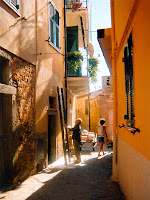 Street scene in Campiglia on the first day of our Cinque Terre hike. The gentleman with the ladder is adding another coat of pastel-colored paint to the wall of a shop.
Street scene in Campiglia on the first day of our Cinque Terre hike. The gentleman with the ladder is adding another coat of pastel-colored paint to the wall of a shop. Our Wayfarers walking group having a big laugh at George's expense. He was late for our departure from Riomaggiore on the second day of our hike, so we ducked into a garage down the street from our hotel and surprised him as he hurried to catch up. Left to right are our guide Paolo, Pauline, Burton, Jean, Barbara, me, Virginia and Nan. While we waited for George, an old man carrying a little boy stopped and asked, "Is it raining?" That was an even bigger laugh.
Our Wayfarers walking group having a big laugh at George's expense. He was late for our departure from Riomaggiore on the second day of our hike, so we ducked into a garage down the street from our hotel and surprised him as he hurried to catch up. Left to right are our guide Paolo, Pauline, Burton, Jean, Barbara, me, Virginia and Nan. While we waited for George, an old man carrying a little boy stopped and asked, "Is it raining?" That was an even bigger laugh. Instead of hiking along the shore between Manorola and Corniglia, we went up and over the large hill that separates them, passing through Volastra where this gentleman was using long-handled shears to harvest grapes from the arbor outside his home.
Instead of hiking along the shore between Manorola and Corniglia, we went up and over the large hill that separates them, passing through Volastra where this gentleman was using long-handled shears to harvest grapes from the arbor outside his home.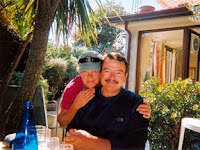 Lunch under the palm trees in Corniglia, the middle one of the five Cinque Terre towns. This was day two of our hike, which took us from Riomaggiore through Manorola and Corniglia to Vernazza.
Lunch under the palm trees in Corniglia, the middle one of the five Cinque Terre towns. This was day two of our hike, which took us from Riomaggiore through Manorola and Corniglia to Vernazza. The beach and harbor in Vernazza, our favorite Cinque Terre town and the place where our second day of hiking ended. From there we took a train to Sestri Levante to begin the Italian Riviera portion of our hike.
The beach and harbor in Vernazza, our favorite Cinque Terre town and the place where our second day of hiking ended. From there we took a train to Sestri Levante to begin the Italian Riviera portion of our hike. Approaching San Fruttuoso by ferry from Punta Chiappa. The church dates from about the fourth century and is the final resting place of many members of the Andrea Doria family.
Approaching San Fruttuoso by ferry from Punta Chiappa. The church dates from about the fourth century and is the final resting place of many members of the Andrea Doria family. Ferryman at the San Fruttuoso dock. It was chilly and sprinkling rain, but he seemed comfortable in his sweater, Madras shorts and bare feet.
Ferryman at the San Fruttuoso dock. It was chilly and sprinkling rain, but he seemed comfortable in his sweater, Madras shorts and bare feet. Lunch on the balcony outside the main restaurant at San Fruttuoso. There was a canopy to protect us from the rain as we enjoyed the food and the view.
Lunch on the balcony outside the main restaurant at San Fruttuoso. There was a canopy to protect us from the rain as we enjoyed the food and the view. Moreno, waiter extraordinaire, at La Bussola in Florence (www.labussolafirenze.it) on our final night in Italy. The restaurant was recommended to us by the concierge at our hotel because it was just around the corner, but we ate dinner there three times during our trip because of the great food and service.
Moreno, waiter extraordinaire, at La Bussola in Florence (www.labussolafirenze.it) on our final night in Italy. The restaurant was recommended to us by the concierge at our hotel because it was just around the corner, but we ate dinner there three times during our trip because of the great food and service.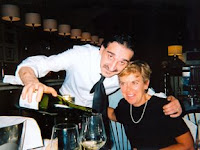 Moreno hams it up for the camera as he pours Nan a glass of vino bianco. Salute!
Moreno hams it up for the camera as he pours Nan a glass of vino bianco. Salute!
Tuesday, December 4, 2007
Going "Nucular" in Iran?
Instead of letting out a big sigh of relief over the fact that Iran has abandoned its nuclear weapons program, indeed that it had done so more than four years ago, back in 2003, Bush attempted to turn the tables, essentially posturing that he was right all along about the threat from Iran. This is especially alarming given that his administration knew back in August that intelligence estimates on Iran were in the process of being re-evaluated. Still he continued to warn of a potential World War III if America did not maintain its aggressive foreign policy position, leading many Americans to expect that we would soon be bombing Iran.
Now it all seems to be just another of Bush's cheesy political ploys--a power play in the run-up to the 2008 election or a chance to bolster his legacy as the "War President"--remarkably and tragically similar to the fake intelligence that led us into the Iraq quagmire. Fool us once, shame on you. Fool us twice, shame on us? I don't think so. This might have worked in the fictional world of George Orwell's 1984, where thanks to "newspeak," black was white, up was down, and left was right, but like the book's Winston character, after our brains stop flopping around in our heads, we realize that this latest gaff is so transparent that any shred of credibility left in this presidency is now completely gone. The legacy? How about "Worst President Ever."
Boat Quest, Part 3
At the end of the review, in the specifications table, I always came up against the hitch: a list price of $36,000. My computer business was having its best year ever, but there was just no way to afford it. That didn't dissuade me from emailing Gerry Hutchins at Com-Pac (www.com-pacyachts.com) and requesting the brochure and price list though. Or, when my parents invited me to join them at their new vacation home in Savannah that following spring, from emailing Gerry to see if I could arrange a side trip to tour the Com-Pac headquarters in Clearwater, Florida. He said I should contact him when I got there, but I never did. It was a 350-mile drive, I would have had to rent a car, and at some point I would have had to say, "Thanks for taking the time to show me around, but I can't really afford to buy one of your boats."
That fantasy pretty much died right there. Only to be replaced by a new one, of course. I can't remember now how I heard about it, but before long I was fascinated by the MacGregor 26 (www.macgregor26.com), another trailerable sailboat, but featuring a water ballast system instead of a keel, at the almost-affordable price of $15,000 (in 1997). The trade-off was that nobody was going to safely sail around the world in a water-ballasted boat. I read one account online of somebody crossing the Gulf Stream from Florida to Bimini in a MacGregor, and even though he did it using just the outboard motor and no sails to make it a fast trip, he still said it was the scariest thing he ever did. So maybe the MacGregor could be the coastal-cruising "trainer" on the way to something bigger and better someday?
Sunday, November 25, 2007
Boat Quest, Part 2
One day in the mid-1990s, I was at the office of one of my computer business clients in downtown Aspen, and I noticed a framed photo of a sailboat on his desk. "Nice boat," I said. "Is it yours?" He said that it was and asked if I had an interest in sailing. "Yes," I said, "but a boat like that is awfully expensive, isn't it?" Not as much as you'd think, he replied, especially for an older, used boat. "Where was that picture taken? It looks like somewhere in the Caribbean." It is, he said. "So how does that work?" I asked. "You're here in Aspen and your boat is down there?" He said that every few months he would fly down to where the boat was stored, sail it to the next destination, put it back in storage, and fly home. In this way, he was slowly touring the Caribbean by sailboat, an island at a time.
The idea I had been holding for more than twenty years that owning a decent-sized boat and sailing it on the ocean was something I might never be able to afford either in terms of money or time was suddenly gone. If this person could do it, I thought, why couldn't I? How to get started though?
About this same time, Phil LeBoutillier walked into my office. He said he was developing a bed and breakfast in the Bahamas (tomatopastehopetown.com) and needed some assistance getting a computerized accounting system set up to track the project. He also said he had noticed my Minifish leaning against a wall out front and wondered if we couldn't maybe work out a trade for some fiberglass repair work. There was still a deep scratch on the bottom from a bad day sailing on Lake Mendota, while I was at the University of Wisconsin in the late 1970s, when I was blown into rocks near the shore. He invited me to come with him to check out his shop a few blocks away where he was building a plywood dinghy for a new trawler he had bought as a transport boat for the bed and breakfast.
The dinghy was a cleverly designed skiff, with the plywood sides and bottom curved around a sturdy frame. Phil was in the process of fiberglassing it so the shop smelled of chemicals. He said that since he was already at it, we should just go get my boat and fix the scratch. We shook on the trade and on our newfound friendship.
When I asked Phil later where he had gotten the plans for his skiff, he handed me a catalog of boat plans. I can't find it now but I know I still have it somewhere, and I think it might have been Fifty Wooden Boats, published by WoodenBoat. In addition to smaller boats like the skiff, there were plans available for cruising sailboats, which I studied carefully. One in particular looked like the right combination of sailplan and layout without being too large to build in a big garage and transport to the ocean by flatbed truck. But did I have the time and more importantly the skills to build a wooden sailboat from scratch?
Tuesday, November 20, 2007
Boat Quest, Part 1
After my family purchased an AMF Alcort Minifish in June of 1969, when I was eleven years old, my interest in sailing never diminished. We would put the boat on top of the station wagon every summer for our vacations to Waupaca or our trips to visit Grandma in Iowa. I kept Royce's Sailing Illustrated next to my bed and studied it nightly until I knew all the concepts and vocabulary, and could tie every knot. My friend Mark Wiars and I even played a sailing board game, Regatta, at his home after school. Mark always won because he saved his Puff cards for the finish.
At that time, we were mostly interested in small sailboats because that was our experience: my family's Minifish, the boats we sailed at Boy Scout camp, the boats we saw sailing on Wisconsin's lakes. Mark and I dreamed of sailing racing boats on Lake Michigan. He was a fan of the Star, while I favored the Lightning. Royce's contained excellent illustrations of both boats, so we would argue their relative merits like other kids argued over which professional athlete was better. Looking at my almost-forty-year-old copy of Royce's just now, I think Mark had the edge since the Star featured a lead keel while the Lightning used a wooden centerboard. On choppy Lake Michigan, the Star would be the safer and faster boat. I think this was the beginning of a long tendency on my part to overestimate a particular boat's seaworthiness.
There were many other boats illustrated in Royce's, including coastal cruisers and passage makers, but as kids we didn't pay much attention to those since they seemed so out of reach. The closest we came to thinking about that type of boat was Dove, the 24-foot sloop that young Robin Graham sailed around the world in the 1960s. As I said in my Introduction, reading a National Geographic article about Robin's circumnavigation was the beginning of my own dream to sail around the world.
Thursday, November 15, 2007
Packers vs. Broncos on Monday Night Football
 Back in July, on the normally unlucky 28th, we were lucky enough to win tickets to the October 29th Monday Night Football game between the Green Bay Packers and the Denver Broncos. If you watched it on TV, you know it was a heckuva game. The Packers won it 19-13 in overtime on the very first play from scrimmage when Brett Favre launched a fifty-yard bomb to Greg Jennings, who took it the rest of the way for a touchdown.
Back in July, on the normally unlucky 28th, we were lucky enough to win tickets to the October 29th Monday Night Football game between the Green Bay Packers and the Denver Broncos. If you watched it on TV, you know it was a heckuva game. The Packers won it 19-13 in overtime on the very first play from scrimmage when Brett Favre launched a fifty-yard bomb to Greg Jennings, who took it the rest of the way for a touchdown.We were up in the nose-bleed section at Invesco Field at Mile High, so it took a long time to work our way down the ramps after the game was over. The energy from the sudden victory was so high that all the Packer fans walking near us chanted "Go, Pack, go!" all the way out of the stadium. It was a veritable Packers lovefest.
Before the game, while I was up in our room at the Hotel Teatro getting ready, Nan took our dog Charlie, always a welcome guest of the hotel, for a quick pre-game walk. As they returned, Brett Favre's wife Deanna and her traveling companions were taking pictures in front of the hotel while they waited for their ride to the game. Charlie, who is a very friendly golden retriever, walked right up to them. It didn't hurt that he was wearing a Packers bandana around his neck. Nan joked that they should have him pose with them, but they were done taking pictures. Deanna petted Charlie for a few seconds and then the moment was over. The luck of this chance encounter surely must have rubbed off on the Packers later that evening. Go, Pack, go!
Tuesday, November 13, 2007
Reflections on Michelangelo's David
 On our final day in Florence, Nan and I visited the Galleria dell'Accademia, home to the original statue of David by Michelangelo. The photo to the left is of the copy in front of the Palazzo Vecchio, which we passed several times while wandering around Florence. This did little, however, to prepare us for seeing the original in its permanent location.
On our final day in Florence, Nan and I visited the Galleria dell'Accademia, home to the original statue of David by Michelangelo. The photo to the left is of the copy in front of the Palazzo Vecchio, which we passed several times while wandering around Florence. This did little, however, to prepare us for seeing the original in its permanent location.I experienced the same rush of emotion when I first spotted David at the end of the hall devoted to Michelangelo's sculptures as I did when I saw Van Gogh's Starry Night in the Museum of Modern Art in New York and Da Vinci's Mona Lisa at the Louvre in Paris. There is something about being in the physical presence of artworks that one has known about their entire life but only previously seen in photographs that is incredibly life-affirming. Yes, it really does exist, and yes, it really is as beautiful as you imagined.
Every photo I had ever seen of David had been taken from the front, and I could never figure out why his hands were positioned as they were. Was his final scrap of clothing flung casually over his shoulder? Did he have an itch he was scratching with that over-sized right hand? As with most displays of sculpture, it was possible to walk completely around David, taking him in from every angle, and that solved the mystery for me. David's sling is slung across his back, the handle end in his right hand and the pouch with the stone in it in his left.
All the descriptions I had ever read, including the one on the plaque in front of the statue, said that David's facial expression was one of confidence in victory, similar to the expression on Donatello's earlier David, who while also naked is wearing a war helmet, holding a sword and standing with one foot on the severed head of Goliath.
When I saw the sling, I suddenly realized that this was completely wrong. David was not contemplating his victory, he was at the moment of attack. His weight was on his right foot, his concentration was focused to his left, and his sling was at the ready. It was easy to imagine him stepping quickly and confidently to his left, at the same time releasing the pouch in his left hand, swinging the sling powerfully around his head and letting fly the fatal stone. The expression on his face is not victorious at all but rather the grim determination of one about to commit a necessary murder.
As I stood there restructuring my thinking, the genius of Michelangelo was apparent. In one statue he had managed to capture the beauty of the human form and the menace of its physicality, the peace of a body at rest and its anticipated motion to violence.
Thursday, November 8, 2007
Pisa and Florence, Part 2
 On our return to Florence by train, Nan and I shared the first leg to Pisa with Burton and Virginia from our Wayfarers hike. They were scheduled to fly out of Pisa the next day, Sunday, while we were set to fly out of Florence on Monday. So we spent the afternoon together wandering around Pisa until Nan and I boarded another train for the final leg to Florence.
On our return to Florence by train, Nan and I shared the first leg to Pisa with Burton and Virginia from our Wayfarers hike. They were scheduled to fly out of Pisa the next day, Sunday, while we were set to fly out of Florence on Monday. So we spent the afternoon together wandering around Pisa until Nan and I boarded another train for the final leg to Florence.Our time in Florence and the Italian Riviera had definitely spoiled us. Except for the area immediately around the famous Leaning Tower, Pisa was sorely lacking in charm. It is a modern, mid-sized port on the Mediterranean, and this function clearly dictates its form, which was evident from our taxi rides to and from the train station--factories, warehouses, wide busy streets, numerous traffic lights, and block after block of post-War two- and three-story brick buildings with shops on the ground floors.
One of the reasons we got off the train in Pisa was that I had convinced Nan we needed to see the Leaning Tower of Pisa as an homage to Galileo and his famous gravity experiment. Galileo is supposed to have climbed to the top of the Tower and dropped two different-sized cannon balls simultaneously. The reasoning of his time was that the larger, heavier ball would fall faster. In fact, they hit the ground at the same time, proving that gravity acts equally upon all objects regardless of mass.
Enough with the science lesson. As with the two previous posts, this one also contains a slideshow. Just click on the Leaning Tower photo if you already have Adobe Flash Player installed. And click here if you don't. The first ten pictures and captions are of the Leaning Tower and the area around it. The remaining ones are from our last full day in Florence. I had just finished reading Ross King's Brunelleschi's Dome, so these final pictures favor Brunelleschi and his work. Salve!
Wednesday, November 7, 2007
Wayfarers Walk: Cinque Terre and Italian Riviera
 Our main reason for traveling to Italy was to join The Wayfarers on their Cinque Terre and Italian Riviera walk, not just to wander around Florence, although you might agree that that was an exceptional experience if you watched the first slideshow, "Flo-rence, Part 1".
Our main reason for traveling to Italy was to join The Wayfarers on their Cinque Terre and Italian Riviera walk, not just to wander around Florence, although you might agree that that was an exceptional experience if you watched the first slideshow, "Flo-rence, Part 1".For those unfamiliar with this part of Italy, here is The Wayfarers introduction:
"The pathways and rocky terraces of the Cinque Terre were forged by the Romans as trade routes. Expanded by the residents of the remote and remarkable "Five Lands," they wind along spectacular bluffs overlooking the Mediterranean, linking five enchanting villages nestled in the cliffs and harbors of the "Italian Riviera." Pastel houses reach down to the sea. Terraced vineyards and olive groves are supported by walls hundreds of years old. World Heritage status assures the preservation of this precious land--its breathtaking natural beauty and cultural treasures. We walk the legendary Sentiero Azzurro and the Via dell'Amore. Their names recall the blue Ligurian Sea and the romance and passion evoked by this magical corner of Northern Italy."
The pictures and captions contained within the Flash-based slideshow capture most of our adventure, and the itinerary below will help with the route and chronology. So if you already have Adobe Flash Player installed, go ahead and click the picture above of the artist painting a picture of Vernazza to go to the second Italy slideshow, "Wayfarers Walk: Cinque Terre and Italian Riviera". If you need to install Flash Player, please click here. As with "Florence, Part 1", there are three different ways to view the show, so be sure to experiment with the different slideshow buttons.
Sunday, September 23: Nan and I took the train from Florence to La Spezia, meeting up with fellow Wayfarers hikers Burton, Virginia and Jean--all from the St. Louis area--along the way. Our guide Paolo and our trip manager Anna met us at the train station and drove us to our hotel in Portovenere. At the Welcome Dinner and Introductory Talk that evening, we met the rest of our hiking group--George from Des Moines, Jerry and Seena from Long Island, and Pauline and Barbara from Long Beach.
Monday, September 24: The Wayfarers van dropped us off in the morning near Campiglia and we hiked to Riomaggiore, the first of the Cinque Terre villages. After lunch, we took a ferry to Monterosso, the last of the Cinque Terre villages. Paolo said the trail between Vernazza and Monterosso was not very interesting so we wouldn't be hiking it, but he wanted to be sure we spent a least a little time in each of the five villages. We explored Monterosso and then took the ferry back to Riomaggiore.
Tuesday, September 25: At the Riomaggiore harbor, we started hiking the Via dell'Amore, passing through the second Cinque Terre village, Manorola, then up to Volastra and down to lunch in Corniglia, the third Cinque Terre village. In the afternoon, we hiked the seaside path to the fourth Cinque Terre village, Vernazza, where we caught a train to our hotel in Sestri Levante.
Wednesday, September 26: The Wayfarers van dropped us off above Sestri Levante and we hiked to Montellegro, where we ate lunch, explored the cathedral and then took the cable car down to Rapallo. We drove to Camogli, which was to be our headquarters for the next three nights.
Thursday, September 27: We caught the bus to the top of Camogli and then hiked through the woods to legendary Portofino, where we ate lunch, shopped and witnessed a water spout over the harbor. In the afternoon, we hiked to Santa Margherita, where we caught a train back to Camogli.
Friday, September 28: From the same spot at the top of Camogli, we hiked down the coast to Punta Chiappa, where we caught a ferry to San Fruttuoso, an ancient Abbey accessible only by sea or by foot. We toured the Abbey and village, ate lunch and then hiked again to Santa Margherita, where we again took the train back to Camogli. That evening we celebrated our successful adventure with a Farewell Dinner.
Saturday, September 29: Nan and I joined Burton and Virginia for a train ride to Pisa, then on to Florence for a couple more days before flying home.
Stay tuned for the final Italy slideshow, "Pisa and Florence, Part 2".
Monday, October 15, 2007
Florence, Part 1
 Nan and I recently returned from our first trip to Italy. We flew into Florence on Thursday, September 20 and wandered the streets for a few days before taking the train on Sunday to the Cinque Terre area. There we met up with a great group of fellow Americans for a six-night, five-day Wayfarers hike (thewayfarers.com). On Saturday, we returned to Florence for a couple of more days before flying home.
Nan and I recently returned from our first trip to Italy. We flew into Florence on Thursday, September 20 and wandered the streets for a few days before taking the train on Sunday to the Cinque Terre area. There we met up with a great group of fellow Americans for a six-night, five-day Wayfarers hike (thewayfarers.com). On Saturday, we returned to Florence for a couple of more days before flying home.We knew this would be the trip of a lifetime for us, so we took plenty of photographs, like this one of the Palazzo Vecchio, Florence's 700-year-old town hall.
With the help of modern technology, I have started putting the images together with captions into Flash-based slideshows. They will display in a standard browser window provided you have the Adobe Flash Player installed. If you need it, click here. If you already have it, click the photo of the Palazzo to go to the first slideshow, "Florence, Part 1". There are three different ways to view the show, so be sure to experiment with the different buttons you'll find.
Separate slideshows of our Wayfarers hike and our second weekend in Florence will follow as they are completed. Enjoy!
Wednesday, September 12, 2007
"It's Time for Change"
During my drive home this evening, traffic was backed up at a four-way stop sign. As I waited to go through, a gentleman in a brand-new, mother of pearl-colored Cadillac Escalade rolled past me on the right. To me, nothing screams "I'm an asshole" louder than a Cadillac Escalade, especially one with that perverse milky paint job.
As he went by, he put his arm out the window in a thumbs-down gesture. At first I was confused. Was he commenting on my driving? But then it occurred to me that he was making a non-verbal comment about my bumper sticker. Everybody is entitled to their opinion, I guess. I smiled and flipped him the bird.
Tuesday, September 11, 2007
9-1-1
As I watched the news reports play out over the next several days and weeks, I kept waiting for someone to comment on the irony of the date. September 11. Nine-eleven. Nine-one-one: the number we call when there is an emergency. Was it just a coincidence that Osama bin Laden would choose this date for the attacks? Or was it intentional, either to send a warning--like the attacks themselves weren't enough of a warning--or to make an extremely dark joke, something like, "Hey, America, better call 9-1-1!"
In his infrequent videotapes, like the one released last week, bin Laden doesn't appear to have much of a sense of humor, unless you count telling us that the war in Iraq would end if we would all just convert to Islam. That made me smile. But he delivered it in such a deadpan manner that you had to think he was serious, not only about that but also about everything else he has done, including the attacks six years ago. Deadly serious. So why is he still alive and threatening us? Maybe it's like a button I saw a few years ago: "Osama bin Forgotten."
Sunday, September 9, 2007
Moby-Dick
Many scholars have concentrated on the insanity of Ahab's obsession. To me, that was merely the device that drove the plot. The greater story is the one of man's place in the universe and his perception of that place. The whalers are routinely successful in their hunt until they finally encounter Moby-Dick at the book's climax. Their incredible hubris is revealed in the absolute destruction the whale wreaks upon their world, killing everyone but Ishmael, the narrator who survives to tell the tale.
The message is that man is but a small component in this universe and that the universe, despite man's feelings to the contrary, is largely indifferent to him. Much of this message is contained within the following paragraph, about two-thirds of the way through the book, when one of the cabin boys, who has joined the chase with the whalers for just his second time, jumps out of the boat in fear:
But it so happened, that those boats, without seeing Pip, suddenly spying whales close to them on one side, turned, and gave chase; and Stubb's boat was now so far away, and he and all his crew so intent upon his fish, that Pip's ringed horizon began to expand around him miserably. By the merest chance the ship itself at last rescued him; but from that hour the little negro went about the deck an idiot; such, at least, they said he was. The sea had jeeringly kept his finite body up, but drowned the infinite of his soul. Not drowned entirely, though. Rather carried down alive to wondrous depths, where strange shapes of the unwarped primal world glided to and fro before his passive eyes; and the miser-merman, Wisdom, revealed his hoarded heaps; and among the joyous, heartless, ever-juvenile eternities, Pip saw the multitudinous, God-omnipresent, coral insects, that out of the firmament of waters heaved the colossal orbs. He saw God's foot upon the treadle of the loom, and spoke it; and therefore his shipmates called him mad. So man's insanity is heaven's sense; and wandering from all mortal reason, man comes at last to that celestial thought, which, to reason, is absurd and frantic; and weal or woe, feels them uncompromised, indifferent as his God.Pip's brush with death exposed to him the truth of man's situation and changed him forever in the eyes of his shipmates. "Insane" is the label others place upon those whose perception does not match their own.
It is apparent why this book created such a sensation when it was published more than 150 years ago. The language and imagery are advanced, even by modern standards. It is a difficult but rewarding book and well worth the time it takes to work through it.
Saturday, July 28, 2007
July 28
In 1987 it was the day I parted company with an employer and immediately started my own somewhat ill-fated computer business, which I ran for ten years and then sold to a former employee whose birthday was July 28. But the sale did not go smoothly and resulted in legal wrangling to reach a settlement.
In 2004 it was the day I founded my eBay business, shortly after being laid off from a great IT job at Aspen Valley Hospital. That business was a financial disaster, so I closed it down after a year to stop the losses.
Today it is July 28 again, and I am trying not to tempt fate. I was going to go on an adventurous solo dirt-bike ride between Gateway, Colorado and Moab, Utah, but Nan talked me out of it after I mentioned that July 28 has been unlucky for me. My luck may be changing though because I was successful, just a few minutes ago when they went on sale, in getting two tickets to the Green Bay Packers vs. Denver Broncos Monday Night Football game on October 29--probably our last chance to see Brett Favre play in person. How lucky is that?!
Tuesday, June 26, 2007
"got jesus?"
Apparently, I'm not the only one. It's gotten so bad that the Pope had to issue the Ten Commandments for Drivers last week. I read them online and it comes down to this: "Drive nice." Hear that? Don't treat freeways like your personal NASCAR race. Don't pass on the right in merge lanes. Don't pretend that your desire to arrive at work on time is more important than other people's. Don't think that tailgating will cause the drivers in front of you to speed up or get out of your way. Don't drive while talking on your cell phone, eating an ice cream cone and steering with your elbows. And if someone lets you pull in ahead of them, wave and smile to acknowledge their courtesy. 'Nuff said.
Sunday, June 10, 2007
Better the Second Time Around
 In some of my first Whispering Jesse blog postings, the "Where's the Dinghy?" series, I detailed our ill-fated May 2004 sailing trip in the British Virgin Islands. We endured a lifetime's worth of sailing misfortunes in a single week, everything from dangerous weather to almost losing our dinghy.
In some of my first Whispering Jesse blog postings, the "Where's the Dinghy?" series, I detailed our ill-fated May 2004 sailing trip in the British Virgin Islands. We endured a lifetime's worth of sailing misfortunes in a single week, everything from dangerous weather to almost losing our dinghy.I'm happy to report that things do indeed go better the second time around. What we learned from the first time's disasters prepared us well for the trip we took last month. It went so well that Nan said it was our best vacation ever. That's a far cry from last time, when in the middle of some particularly bad weather Nan said she hated sailing and would never do it again.
 Here's what we did differently this time:
Here's what we did differently this time:Instead of sailing with only the two of us, we recruited Nan's sister Monica and her friend Vicky to join us. Neither had ever sailed before but they were quick learners and excellent shipmates.
Instead of scheduling our flights with no room for error, we took the time to find flights that would give us options and get us from Denver to the British Virgin Islands in just one day, with time to spare in case of problems.
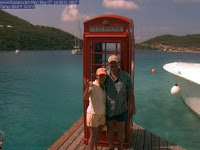 Instead of assuming our luggage would arrive when we did, we packed some toiletries and clothes in our carry-ons.
Instead of assuming our luggage would arrive when we did, we packed some toiletries and clothes in our carry-ons.Instead of using a smaller, less expensive charter company, we went with the biggest and best, the Moorings, out of Road Town harbor on Tortola.
 Instead of going with a smaller boat, we went with a forty-foot Beneteau, the 403 Club. It made for a smoother ride and much more cabin room, plus it included such niceties as an auto-pilot and an electric anchor windlass.
Instead of going with a smaller boat, we went with a forty-foot Beneteau, the 403 Club. It made for a smoother ride and much more cabin room, plus it included such niceties as an auto-pilot and an electric anchor windlass.Instead of staying at an expensive hotel the night before our charter began, we stayed on the boat and got well-acquainted with its systems before heading out the next day.
 Instead of sailing around Tortola clockwise, which is somewhat contrary to the prevailing easterly Trade Winds, especially on the north side of the island, we sailed counter-clockwise and enjoyed the benefits of never having to use the engine to make headway.
Instead of sailing around Tortola clockwise, which is somewhat contrary to the prevailing easterly Trade Winds, especially on the north side of the island, we sailed counter-clockwise and enjoyed the benefits of never having to use the engine to make headway.Instead of assuming the boat would have adequate water and fuel, and that every mooring area would have a water and fuel dock, we planned our itinerary to include strategic refueling stops at Marina Cay and Sopers Hole.
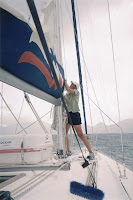 Instead of assuming that we would be able to get a day mooring at the Baths--no anchoring allowed!--we spent the previous night at the closest overnight spot, Manchioneel Bay on Cooper Island. We were underway by 6:15 the next morning and were the first boat to arrive at the Baths that day.
Instead of assuming that we would be able to get a day mooring at the Baths--no anchoring allowed!--we spent the previous night at the closest overnight spot, Manchioneel Bay on Cooper Island. We were underway by 6:15 the next morning and were the first boat to arrive at the Baths that day.Instead of thinking I knew where I was going as we tried to enter North Gorda Sound and almost heading out to open sea by mistake, I checked and rechecked the chart, and entered the sound safely through the Mosquito Island channel.
Instead of using a long line to attach our dinghy to our Marina Cay mooring while we refueled, and then running over it and fouling our propeller on the return, we tied the dinghy up close to the buoy and motored up to it extra-cautiously.
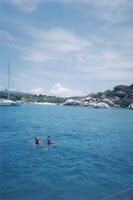 Instead of thinking there would be plenty of moorings available at Jost Van Dyke, we sailed early from Tortola's Cane Garden Bay to White Bay and tied off our dinghy to an open mooring buoy, then made a side trip to Sandy Cay. When we returned all the other moorings were taken.
Instead of thinking there would be plenty of moorings available at Jost Van Dyke, we sailed early from Tortola's Cane Garden Bay to White Bay and tied off our dinghy to an open mooring buoy, then made a side trip to Sandy Cay. When we returned all the other moorings were taken.Instead of arriving late to the Sopers Hole and Norman Island mooring areas and ending up with windy, noisy moorings, we made a point of sailing early in the day and were rewarded with quiet, protected moorings, the one at Norman Island being the best of the trip, with excellent snorkeling right next to the boat.
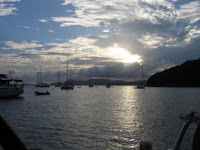 Instead of suffering twenty-plus knot winds, four to six foot swells and frequent squalls, we were lucky to have fifteen to twenty knot winds, minimal swells and partly cloudy skies--perfect weather almost the entire week.
Instead of suffering twenty-plus knot winds, four to six foot swells and frequent squalls, we were lucky to have fifteen to twenty knot winds, minimal swells and partly cloudy skies--perfect weather almost the entire week.As good as it was, the trip was not without incident:
Monica took a bad fall going down the steps into the cabin, cracking two ribs and bruising a wrist. She had taken off her sandy shoes in the cockpit before descending, and her wet feet slipped out from under her at the bottom, causing her to fall back hard against the steps. She was a trouper, only complaining when we made her laugh.
 We failed to notice an approaching boat as we were casting off the water dock at Sopers Hole and had to take evasive action, which resulted in us being pinned by the wind to the windward side of an adjacent dock. Fortunately, we didn't cause any damage to the boat, but I think I swore myself hoarse. We would have been forced to wait for the wind to die in order to make our escape, but a smart bystander directed a man in a dinghy to come under the dock from the leeward side and push our bow out into the wind while I gunned the engine and steered us out of there. It worked like a charm.
We failed to notice an approaching boat as we were casting off the water dock at Sopers Hole and had to take evasive action, which resulted in us being pinned by the wind to the windward side of an adjacent dock. Fortunately, we didn't cause any damage to the boat, but I think I swore myself hoarse. We would have been forced to wait for the wind to die in order to make our escape, but a smart bystander directed a man in a dinghy to come under the dock from the leeward side and push our bow out into the wind while I gunned the engine and steered us out of there. It worked like a charm.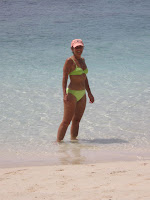 Hey, if everything went perfectly, it wouldn't be an adventure now, would it?
Hey, if everything went perfectly, it wouldn't be an adventure now, would it?Here was our itinerary for the week:
Day 1, Saturday, May 5: Moorings Charter Base in Road Town, Tortola to Manchioneel Bay at Cooper Island.
Day 2, Sunday, May 6: Cooper Island to the Bitter End Yacht Club at North Gorda Sound, Virgin Gorda, with a four-hour stop at the Baths.
Day 3, Monday, May 7: Virgin Gorda to Marina Cay.
 Day 4, Tuesday, May 8: Marina Cay to Cane Garden Bay on the north coast of Tortola.
Day 4, Tuesday, May 8: Marina Cay to Cane Garden Bay on the north coast of Tortola.Day 5, Wednesday, May 9: Tortola to White Bay at Jost Van Dyke, with a side trip to Sandy Cay.
Day 6, Thursday, May 10: Jost Van Dyke to Sopers Hole at Tortola's west end.
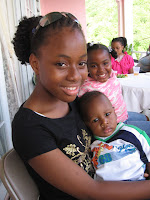 Day 7, Friday, May 11: Tortola to the Bight at Norman Island, with an unsuccessful snorkeling stop at the Indians. This time, all the day moorings were already taken.
Day 7, Friday, May 11: Tortola to the Bight at Norman Island, with an unsuccessful snorkeling stop at the Indians. This time, all the day moorings were already taken.Day 8, Saturday, May 12: Norman Island to Moorings Charter Base.
Monica and Vicky flew home the next day, but Nan and I spent an extra week at a villa on Cane Garden Bay owned and operated by our friends, Allan and Joycelyn Rhymer. They invited us to a festive Mothers' Day luncheon and made the second half of our vacation a joy with their boundless hospitality.
Next time, north to Anegada!
Saturday, April 28, 2007
Why I Vote Democratic
I have voted in every presidential election since 1976, eight in all so far. In fact, I vote in every election, whether it's mid-term, referendum or special. And I have never voted for a Republican candidate. Not once. It's not that there maybe aren't some worthy Republicans running for office, but they'll never get my vote because of what the Republican Party stands for to me.
If you have read this blog before, you know that I value nothing more than fairness, personal freedom and thinking for oneself. I don't believe the government should legislate morality or otherwise concern itself with the behavior of its people unless that behavior infringes on the rights and freedoms of others. On the Left vs. Right scale, this puts me pretty far out to the Left, just shy of anarchy, and at almost the polar opposite of modern Republicans, who seem to want to control every aspect of people's lives and make each other rich at the expense of those less fortunate.
When I was younger, I believed it was important to vote my beliefs, so I voted for Independent candidate Eugene McCarthy in 1976 and People's Party candidate Barry Commoner in 1980. I think each received less than one percent of the vote in their respective elections, but this dismal showing didn't change my thinking so much as watching the 1980 presidential election returns did.
I remember sitting in my friend Curt Haensel's apartment in Madison while we were both still in college there, watching in utter disbelief as Ronald Reagan beat Jimmy Carter to become president. It was like watching the death of hope. It was like, what were the 1960s, the Civil Rights Movement, the Vietnam protests, the Feminist Movement, the Watergate trials and all the other progressive events of our lifetimes all about? How could it all have led up to this, America putting the brakes on the free society it had been creating since John Kennedy was elected?
What followed was twelve years of nothing socially good or progressive happening, eight with Reagan and then another four with the first Bush. Money that had been budgeted for programs benefiting the people was now reallocated to defense. We outspent the Soviets and ended the Cold War. But to whose benefit? The Soviet Union splintered into several poverty-stricken, corrupt fiefdoms. America was now the world's sole superpower, and the rest of the world had better watch out, as we proved in the Gulf War. We began meddling in the affairs of other countries, toppling disagreeable leaders and providing arms for uprisings. When questions were raised, ignorance or forgetfulness were claimed. Conservative values became "family values." The anti-abortion movement gained ground. The national debt climbed into the trillions. Nationalism was seen as a virtue. And the rich got richer, the poor poorer.
While all this was going on, there were presidential elections in 1984 and 1988. I voted for Democratic candidate Walter Mondale in 1984, and I voted for Democratic candidate Michael Dukakis in 1988. Neither won of course, but I was no longer voting my beliefs, I was voting my conscience. Enough with the independents! If my vote would help get the neo-conservative Republican monsters out of office, that was good enough for me.
I have voted Democratic ever since--the straight party ticket every time. If ever I have a doubt, I just need to be reminded with situations like the recent voting of Ronald Reagan as "Greatest American in History." Ahead of Abraham Lincoln. Give me a break! The nostalgia our society feels for this era of rah-rah conservatism and "America first" is completely beyond my understanding.
Hope lives again though, in the form of Democratic candidate Barack Obama. He is the breath of fresh air we all need right now. A man of the people and for the people. He will be elected our next president, and he will put us back on the path to freedom and equality for all.
Thursday, April 26, 2007
Republicans equal life; Democrats equal death?
A special comment about Rudolph Giuliani’s remarks at a Lincoln Day dinner in New Hampshire:
Since some indeterminable hour between the final dousing of the pyre at The World Trade Center, and the breaking of what Sen. Barack Obama has aptly termed "9/11 fever," it has been profoundly and disturbingly evident that we are at the center of one of history’s great ironies.
Only in this America of the early 21st century could it be true that the man who was president during the worst attack on our nation and the man who was the mayor of the city in which that attack principally unfolded would not only be absolved of any and all blame for the unreadiness of their own governments, but, moreover, would thereafter be branded heroes of those attacks.
And now, that mayor — whose most profound municipal act in the wake of that nightmare was to suggest the postponement of the election to select his own successor — has gone even a step beyond these M.C. Escher constructions of history.
"If any Republican is elected president — and I think obviously I would be best at this — we will remain on offense and will anticipate what (the terrorists) will do and try to stop them before they do it."
Insisting that the election of any Democrat would mean the country was "back ... on defense," Mr. Giuliani continued: "But the question is how long will it take and how many casualties will we have. If we are on defense, we will have more losses and it will go on longer."
He said this with no sense of irony, no sense of any personal shortcomings, no sense whatsoever.
And if you somehow missed what he was really saying, somehow didn’t hear the none-too-subtle subtext of "vote Democratic and die," Mr. Giuliani then stripped away any barrier of courtesy, telling Roger Simon of politico.com:
"America will be safer with a Republican president."
At least that Republican president under which we have not been safer has, even at his worst, maintained some microscopic distance between himself and a campaign platform that blithely threatened the American people with "casualties" if they, next year, elect a Democratic president — or, inferring from Mr. Giuliani’s flights of grandeur in New Hampshire — even if they elect a different Republican.
How ... dare ... you, sir?
"How many casualties will we have?" — this is the language of Osama bin Laden.
Yours, Mr. Giuliani, is the same chilling nonchalance of the madman, of the proselytizer who has moved even from some crude framework of politics and society, into a virtual Roman Colosseum of carnage, and a conceit over your own ability — and worthiness — to decide who lives and who dies.
Rather than a reasoned discussion — rather than a political campaign advocating your own causes and extolling your own qualifications — you have bypassed all the intermediate steps and moved directly to trying to terrorize the electorate into viewing a vote for a Democrat, not as a reasonable alternative and an inalienable right ... but as an act of suicide.
This is not the mere politicizing of Iraq, nor the vague mumbled epithets about Democratic "softness" from a delusional vice president.
This is casualties on a partisan basis — of the naked assertion that Mr. Giuliani’s party knows all and will save those who have voted for it — and to hell with everybody else.
And that he, with no foreign policy experience whatsoever, is somehow the messiah-of-the-moment.
Even to grant that that formula — whether posed by Republican or Democrat — is somehow not the most base, the most indefensible, the most un-American electioneering in our history — even if it is somehow acceptable to assign "casualties" to one party and "safety" to the other — even if we have become so profane in our thinking that it is part of our political vocabulary to view counter-terror as one party’s property and the other’s liability ... on what imaginary track record does Mr. Giuliani base his boast?
Which party held the presidency on Sept. 11, 2001, Mr. Giuliani?
Which party held the mayoralty of New York on that date, Mr. Giuliani?
Which party assured New Yorkers that the air was safe and the remains of the dead recovered and not being used to fill potholes, Mr. Giuliani?
Which party wanted what the terrorists wanted — the postponement of elections — and to whose personal advantage would that have redounded, Mr. Giuliani?
Which mayor of New York was elected eight months after the first attack on the World Trade Center, yet did not emphasize counter-terror in the same city for the next eight years, Mr. Giuliani?
Which party had proposed to turn over the Department of Homeland Security to Bernard Kerik, Mr. Giuliani?
Who wanted to ignore and hide Kerik’s organized crime allegations, Mr. Giuliani?
Who personally argued to the White House that Kerik need not be vetted, Mr. Giuliani?
Which party rode roughshod over Americans’ rights while braying that it was actually protecting them, Mr. Giuliani?
Which party took this country into the most utterly backwards, utterly counterproductive, utterly ruinous war in our history, Mr. Giuliani?
Which party has been in office as more Americans were killed in the pointless fields of Iraq than were killed in the consuming nightmare of 9/11, Mr. Giuliani?
Drop this argument, sir.
You will lose it.
"The Democrats do not understand the full nature and scope of the terrorist war against us," Mr. Giuliani continued to the Rockingham County Lincoln Day Dinner last night. "Never, ever again will this country be on defense waiting for (terrorists) to attack us, if I have anything to say about it. And make no mistake, the Democrats want to put us back on defense."
There is no room for this.
This is terrorism itself, dressed up as counter-terrorism.
It is not warning, but bullying — substituted for the political discourse now absolutely essential to this country’s survival and the freedom of its people.
No Democrat has said words like these. None has ever campaigned on the Republicans’ flat-footedness of Sept. 11, 2001. None has the requisite, irresponsible, all-consuming ambition. None is willing to say "I accuse," rather than recognize that, to some degree, all of us share responsibility for our collective stupor.
And if it is somehow insufficient, that this is morally, spiritually, and politically wrong, to screech as Mr. Giuliani has screeched, there is also this: that gaping hole in Mr. Giuliani’s argument of "Republicans equal life; Democrats equal death."
Not only have the Republicans not lived up to their babbling on this subject, but last fall the electorate called them on it.
As doubtless they would call you on it, Mr. Giuliani.
Repeat — go beyond — Mr. Bush’s rhetorical calamities of 2006.
Call attention to the casualties on your watch, and your long, waking slumber in the years between the two attacks on the World Trade Center.
Become the candidate who runs on the Vote-For-Me-Or-Die platform.
Do a Joe McCarthy, a Lyndon Johnson, a Robespierre.
Only, if you choose so to do, do not come back surprised nor remorseful if the voters remind you that "terror" is not just a matter of "casualties." It is, just as surely, a matter of the promulgation of fear.
Claim a difference between the parties on the voters’ chances of survival — and you do bin Laden’s work for him.
And we — Democrats and Republicans alike, and every variation in between — We Americans! — are sick to death of you and the other terror-mongers trying to frighten us into submission, into the surrender of our rights and our reason, into this betrayal of that for which this country has always stood.
Franklin Roosevelt’s words ring true again tonight.
And, clarified and amplified, they are just as current now as they were when first he spoke them, 74 years ago.
"We have nothing to fear but fear itself" — and those who would exploit our fear, for power and for their own personal, selfish, cynical, gain.
Good night, and good luck.
Friday, April 20, 2007
So it goes.
I was introduced to Kurt Vonnegut in my early teens in the early 1970s. My mother brought a copy of Cat's Cradle on one of our summer lake vacations to Waupaca, Wisconsin, and she thought I would enjoy it. I did. And I shared it with my friend John Shepherd. Before long, we had each read all of Mr. Vonnegut's fiction. His stories validated our adolescent discovery that life was absurd and that nobody really knew what was going on. We especially enjoyed Slaughterhouse-Five and its premise that Billy Pilgrim had become unstuck in time. As I have gotten older, that idea has come back to me frequently as random memories of my life leap to mind at odd moments for no apparent reason. Of course, I only live in moments that have already occurred, not also in the future as Billy Pilgrim did. "So it goes."
The many excellent short stories in Welcome to the Monkey House were a revelation for John and me. We laughed out loud at several of them and were deeply moved by others. I still reference the equality-at-any-cost idea behind "Harrison Bergeron"; get misty thinking of the young lovers in "Long Walk to Forever"; and wonder if my dog is as smart as "Thomas Edison's Shaggy Dog".
In 1976, while attending the University of Iowa, I had the great good fortune to see Kurt Vonnegut speak at McBride Auditorium. He spoke of his work with the university's Writers' Workshop and answered questions from the audience, but what I remember most clearly was his reading of the first chapter of his work-in-progress, Jailbird. When he came to the description of the homeless woman with old love letters stuffed in her shoes and revealed that the letters were from the story's narrator, Walter Starbuck, there was an audible gasp in the auditorium, followed by a raucous standing ovation. Such was the power of Kurt Vonnegut as a storyteller.
To use the greeting of Billy Pilgrim's Tralfamadorian abductors: Mr. Vonnegut, hello. Good-bye. Hello.
Wednesday, February 14, 2007
Fort Lauderdale to Bahamas Sailing Trip
 Day 1: "Quetzal", the 1987 47-foot Kaufman cutter-rigged sailboat that was to be our lodging and transportation for the next 5 days, slipped at the Bahia Mar marina. 6'-7" Harry is seen ducking out of the companionway. Fort Lauderdale's famous beaches are beyond the palm trees in the distance.
Day 1: "Quetzal", the 1987 47-foot Kaufman cutter-rigged sailboat that was to be our lodging and transportation for the next 5 days, slipped at the Bahia Mar marina. 6'-7" Harry is seen ducking out of the companionway. Fort Lauderdale's famous beaches are beyond the palm trees in the distance. With the weather not cooperating for a Bahamas passage due to winds directly out of the east at 25 knots, we agree to sail along the coast for a day or two while we wait for conditions to improve. Here is Capt. John at the helm as we motor along the Intracoastal Waterway on our way to open ocean, while Bill checks the available real estate lining the shore.
With the weather not cooperating for a Bahamas passage due to winds directly out of the east at 25 knots, we agree to sail along the coast for a day or two while we wait for conditions to improve. Here is Capt. John at the helm as we motor along the Intracoastal Waterway on our way to open ocean, while Bill checks the available real estate lining the shore.
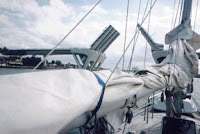 Approaching the 17th St. Causeway, with the drawbridge opened obligingly for our passage. Beyond the bridge are Lake Mabel and then the Atlantic Ocean. We spent the afternoon sailing down to the Miami Beach Marina, where we spent the night. The next day, we sailed south in the protected waters of Biscayne Bay ("where the Cuban gentlemen sleep all day," according to Steely Dan's song "Dr. Wu"), ending up at the Dinner Key Marina in Coconut Grove for our second night.
Approaching the 17th St. Causeway, with the drawbridge opened obligingly for our passage. Beyond the bridge are Lake Mabel and then the Atlantic Ocean. We spent the afternoon sailing down to the Miami Beach Marina, where we spent the night. The next day, we sailed south in the protected waters of Biscayne Bay ("where the Cuban gentlemen sleep all day," according to Steely Dan's song "Dr. Wu"), ending up at the Dinner Key Marina in Coconut Grove for our second night.
 Day 3: Bahamas or bust! We left Coconut Grove before dawn and retraced our route north to Fort Lauderdale in order to get a good southeast tack toward Bimini before heading northeast to Grand Bahama Island.
Day 3: Bahamas or bust! We left Coconut Grove before dawn and retraced our route north to Fort Lauderdale in order to get a good southeast tack toward Bimini before heading northeast to Grand Bahama Island.
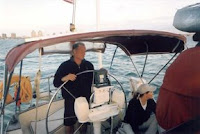 Heading out into the Gulf Stream, where John promised us the sailing would be "lumpy." Velinda had sailed us under the William M. Powell Bridge and out through the rough waters into the Atlantic. Now she was relaxing but keeping an eye on the water.
Heading out into the Gulf Stream, where John promised us the sailing would be "lumpy." Velinda had sailed us under the William M. Powell Bridge and out through the rough waters into the Atlantic. Now she was relaxing but keeping an eye on the water.
 Same moment, different angle. Velinda, Harry and Phil hang out in the cockpit on the morning of our Bahamas crossing. Phil appears a little damp from getting "douched" while managing the headsail from the foredeck.
Same moment, different angle. Velinda, Harry and Phil hang out in the cockpit on the morning of our Bahamas crossing. Phil appears a little damp from getting "douched" while managing the headsail from the foredeck.
 Day 4: We survived the night! Of course we had to make frequent course corrections and dodge all-night cruise ship traffic, but the sun rose just the same. Luisa enjoys her first cup of coffee with an unfortunate flying fish that landed on deck during the night.
Day 4: We survived the night! Of course we had to make frequent course corrections and dodge all-night cruise ship traffic, but the sun rose just the same. Luisa enjoys her first cup of coffee with an unfortunate flying fish that landed on deck during the night.
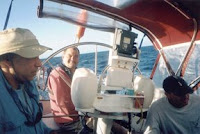 Bill and I pulled the first and last watch shifts, so neither of us got much sleep. Here a tired Bill mans the helm--thank goodness for autohelm--while Harry and Phil anticipate breakfast.
Bill and I pulled the first and last watch shifts, so neither of us got much sleep. Here a tired Bill mans the helm--thank goodness for autohelm--while Harry and Phil anticipate breakfast.
Land ho! After almost 30 hours under sail, we spot The Settlement at the west end of Grand Bahama Island.
The marina at Old Bahama Bay Resort & Yacht Harbour (http://www.oldbahamabay.com/). The water was a brilliant turquoise blue. Here is a Compac 25 sloop we shared the dock with during our brief overnight visit. Note the classic Caribbean architecture and pastel colors of the resort.

Group shot on the pier in front of Bonefish Folley's restaurant. We dined on conch fritters and other seafood specialties, washed down with local Kalik beer. Left to right are me, Velinda, Bill, Harry, Luisa, Phil and Capt. John.
 Day 5: The voyage home took only eight hours on a smooth broad reach. Capt. John had us rig up a whisker pole on the jib and a preventer on the mainsail for performance and safety. And we finally had a chance to practice with a sextant, correctly calculating our latitude to the degree and minute. Here I am at the helm for the last time.
Day 5: The voyage home took only eight hours on a smooth broad reach. Capt. John had us rig up a whisker pole on the jib and a preventer on the mainsail for performance and safety. And we finally had a chance to practice with a sextant, correctly calculating our latitude to the degree and minute. Here I am at the helm for the last time.



